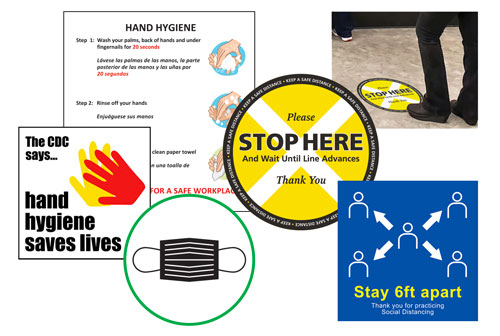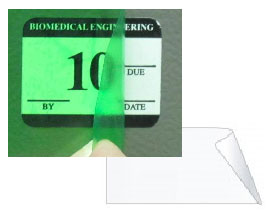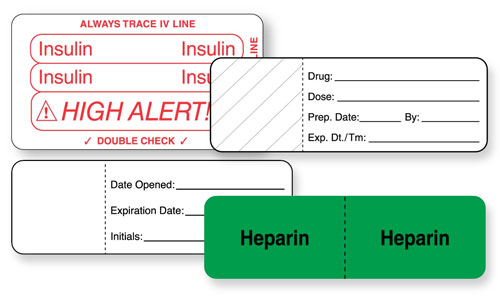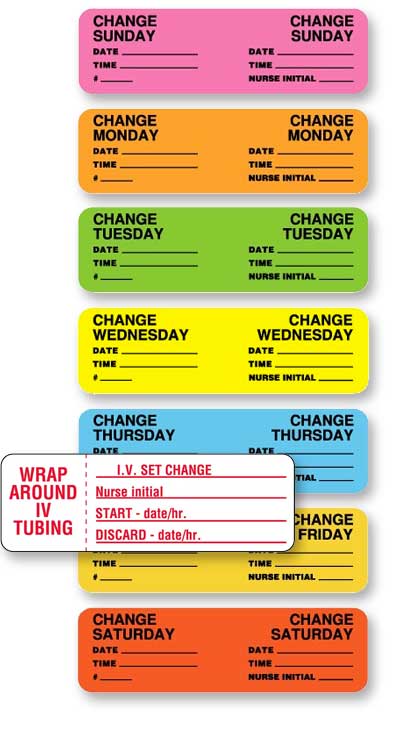COVID-19 caused rapid changes in protocols and policies. But the communication methods typically used to communicate this information, like text-heavy email updates, were not entirely effective. Overwhelmed inboxes combined with the inability of many healthcare workers to access computers because of PPE limitations, decreased the value of email as a sole communication channel.
Communications
Enter graphic communications. Conveniently placed signage noting changes, instructions to staff about testing protocols, patient information and safeguards played an essential role. It allowed staff to access information in real time without consulting their electronic devices and enhanced information retention. Posting guidance in high traffic locations including:
- Areas outside patient rooms
- Nursing stations
- Break rooms
- Elevators
...allowed for just-in-time visual communications.
Implementing these communication methods will ensure the target information reaches its busy audience successfully and repeatedly.
Plus, when communications are visual it enhances retention. In fact, people remember up to 80% of what they see, compared to only about 20% of what they read.
Taking these steps minimizes confusion and augments clarity.
Visitor Management
Visitors can help patients recover faster and reduce their anxiety and stress. But, COVID-19 halted virtually all in person visits. Although restrictions will moderate somewhat as the virus caseload decreases, reopening for non COVID-19 related care will like include these ongoing changes:
- Restricting the total number of visitors allowed
- Controlling lines and maintaining appropriate physical distances
- Conducting temperature checks on each visitor
- Marking badges that show that visitors have been checked and approved for entry
In addition, managing waiting areas, cafeterias and other spots where people congregate will take on increased importance. Changing layouts and reorganizing the seating will naturally restrict contact. But, it’s also important to detail expectations. Showing people where to stand while in line and reminding them to maintain a social distance, wear masks and practice hand hygiene are important considerations.
Increased Focus On Cleaning
Cleaning, disinfecting and other infection prevention steps have long been at the forefront of patient safety. But, the importance of cleaning will escalate for all organizations, especially healthcare.
Cleaning and disinfecting objects and surfaces, especially those that are frequently touched (such as doorknobs, handles, tabletops, etc.) take on greater importance. In addition, monitoring medical devices that can’t go through automatic washers and ultrasonic cleaners will be necessary to ensure proper manual cleaning techniques are used.
Further, if a COVID-19 exposure occurs in a physician’s office or clinic and in hospitals where COVID-19 patients are housed, it requires using EPA registered industrial-strength disinfectants with a broad spectrum kill claim.
In fact, a recent study found that the novel coronavirus can survive up to three days on plastic and stainless steel, both of which are commonly found in clinical equipment.
Unfortunately, cleansers and disinfectants have an unintended side effect. The chemicals can obscure important clinical data. In fact, safety, service, maintenance, inspection and testing information can easily become illegible or get removed entirely from a medical device.
For devices where this information is essential, adjusting the type of materials used to mark the equipment will prevent missteps. For example, unishield label protector overlays protect the label beneath from cleansers, abrasives and contaminants. Plus, self-laminating options, including a clear base label, gives you a secure surface to apply your label to equipment and protect any notes written on the label from those cleaning chemicals.
Medication Safety
As healthcare professionals searched for drugs that could curb the severity of COVID-19 it spawned an “Internet Drug Of The Month” phenomena.
For example, hydroxychloroquine quickly went from in vogue to risky to not used. Azithromycin was also studied as a possible treatment. But, it caused an abnormal heart rhythm in some patients.
More recently, Remdesivir was authorized for emergency use of COVID-19 but dosing created some challenges. Further, an imported drug, Propofol, sometimes used with patients on ventilators, has a new concentration.
Building a best practice alert in the EHR system is the best solution to combat these issues. But, if developing an algorithm to alert the medical staff when researching the drug isn’t feasible, labeling the medication with appropriate warnings is a useful substitute.
Elective Procedures
With resources laser focused on treating COVID-19 patients, healthcare supply chain professionals centered on procuring PPE, testing reagents, ventilators and more. With elective procedures paused and non essential personnel furloughed, there was little need to monitor supplies associated with those areas.
But as the healthcare systems begin reopening for non COVID-19 related care, those supplies become essential to delivering safe and effective patient care.
For example, ensuring nurses have frequently-needed items in patient rooms or in their carts eliminates their need to track down supplies instead of caring for patients. Plus, maintaining multiple stockrooms and supply cabinets, that contain a wider variety of items, throughout the facility, makes it easy for them to restock.
Start by defining the items that nurses need frequently and on demand. For example, IV labels are one of those frequently used items. IV set changes and change minders label kits take up a small footprint on shelfs or carts and are important to stock.
Minimizing the time and effort nurses spend on unnecessary tasks increases the time they spend with patients.
Thoughtful face-to-face patient communication and one-to-one interaction with the clinical staff have proven to enhance patient care and improve patient satisfaction. Supplementing those conversations with other forms of communication, including labels, will help you to further augment your care.
United Ad Label
UAL’s label and healthcare knowledge helps to elevate communications and aid health systems reopening for non COVID-19 related care. Contact us to learn more.




